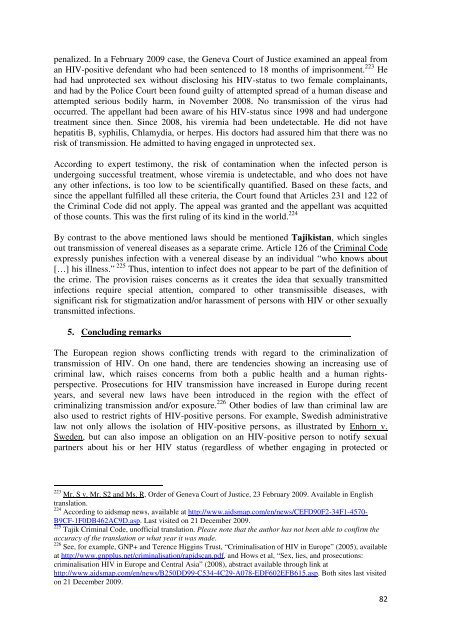Johanna Westeson - The ICHRP
Johanna Westeson - The ICHRP
Johanna Westeson - The ICHRP
Create successful ePaper yourself
Turn your PDF publications into a flip-book with our unique Google optimized e-Paper software.
penalized. In a February 2009 case, the Geneva Court of Justice examined an appeal from<br />
an HIV-positive defendant who had been sentenced to 18 months of imprisonment. 223 He<br />
had had unprotected sex without disclosing his HIV-status to two female complainants,<br />
and had by the Police Court been found guilty of attempted spread of a human disease and<br />
attempted serious bodily harm, in November 2008. No transmission of the virus had<br />
occurred. <strong>The</strong> appellant had been aware of his HIV-status since 1998 and had undergone<br />
treatment since then. Since 2008, his viremia had been undetectable. He did not have<br />
hepatitis B, syphilis, Chlamydia, or herpes. His doctors had assured him that there was no<br />
risk of transmission. He admitted to having engaged in unprotected sex.<br />
According to expert testimony, the risk of contamination when the infected person is<br />
undergoing successful treatment, whose viremia is undetectable, and who does not have<br />
any other infections, is too low to be scientifically quantified. Based on these facts, and<br />
since the appellant fulfilled all these criteria, the Court found that Articles 231 and 122 of<br />
the Criminal Code did not apply. <strong>The</strong> appeal was granted and the appellant was acquitted<br />
of those counts. This was the first ruling of its kind in the world. 224<br />
By contrast to the above mentioned laws should be mentioned Tajikistan, which singles<br />
out transmission of venereal diseases as a separate crime. Article 126 of the Criminal Code<br />
expressly punishes infection with a venereal disease by an individual “who knows about<br />
[…] his illness.” 225 Thus, intention to infect does not appear to be part of the definition of<br />
the crime. <strong>The</strong> provision raises concerns as it creates the idea that sexually transmitted<br />
infections require special attention, compared to other transmissible diseases, with<br />
significant risk for stigmatization and/or harassment of persons with HIV or other sexually<br />
transmitted infections.<br />
5. Concluding remarks<br />
<strong>The</strong> European region shows conflicting trends with regard to the criminalization of<br />
transmission of HIV. On one hand, there are tendencies showing an increasing use of<br />
criminal law, which raises concerns from both a public health and a human rightsperspective.<br />
Prosecutions for HIV transmission have increased in Europe during recent<br />
years, and several new laws have been introduced in the region with the effect of<br />
criminalizing transmission and/or exposure. 226 Other bodies of law than criminal law are<br />
also used to restrict rights of HIV-positive persons. For example, Swedish administrative<br />
law not only allows the isolation of HIV-positive persons, as illustrated by Enhorn v.<br />
Sweden, but can also impose an obligation on an HIV-positive person to notify sexual<br />
partners about his or her HIV status (regardless of whether engaging in protected or<br />
223 Mr. S v. Mr. S2 and Ms. R, Order of Geneva Court of Justice, 23 February 2009. Available in English<br />
translation.<br />
224 According to aidsmap news, available at http://www.aidsmap.com/en/news/CEFD90F2-34F1-4570-<br />
B9CF-1F0DB462AC9D.asp. Last visited on 21 December 2009.<br />
225 Tajik Criminal Code, unofficial translation. Please note that the author has not been able to confirm the<br />
accuracy of the translation or what year it was made.<br />
226 See, for example, GNP+ and Terence Higgins Trust, “Criminalisation of HIV in Europe” (2005), available<br />
at http://www.gnpplus.net/criminalisation/rapidscan.pdf, and Hows et al, “Sex, lies, and prosecutions:<br />
criminalisation HIV in Europe and Central Asia” (2008), abstract available through link at<br />
http://www.aidsmap.com/en/news/B250DD99-C534-4C29-A078-EDF602EFB615.asp. Both sites last visited<br />
on 21 December 2009.<br />
82
















